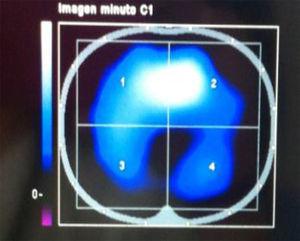Determinar la presión arterial de dioxide de carbono, en pacientes con soporte ventilatorio completo, mediante dos técnicas de monitorización no invasivas, la calorimetría indirecta (eliminación de CO2) y la capniografía (presión teleespiratoria de CO2). Comparar sus resultados frente a los obtenidos mediante la extracción de gasometrías arteriales
MétodosVeinte pacientes en ventilación mecánica, sometidos a un cambio en el volumen ventilatorio, fueron monitorizados con un computador metabólico (Deltatrac) y un capniógrafo. Se determinaron las siguientes variables antes y después del cambio ventilatorio: eliminación de CO2 (VeCO2), consumo de oxígeno, PETCO2 y PaCO2 (gasometría arterial). Se calcularon los nuevos niveles de PaCO2 mediante calorimetría indirecta utilizando PaCO2-final = PaCO2-basal ´ VeCO2-basal/VeCO2-1 minuto, y mediante capniografía, utilizando PaCO2-final = PETCO2-final + Grad (PaCO2-PETCO2)
ResultadosLos niveles de PaCO2 obtenidos mediante calorimetría indirecta fueron de 37 (DE 5,2) mmHg y mediante la PETCO2 de 35,4 (8,3) mmHg; tras la extracción de gases arteriales los niveles fueron de 37,1 (6,4) mmHg y 37,2 (6,7) mmHg, respectivamente. La correlación entre la PaCO2 calculada y la medida mediante gasometrías arteriales fue de r = 0,93 (p <0,001) para la calorimetría indirecta y de r = 0,55 (p <0,05) para la PETCO2. En el análisis de concordancia de ambas técnicas frente a la gasometría arterial los límites de acuerdo fueron más estrechos para la calorimetría indirecta (–5,11/5,31 mmHg frente a –12,35/16,07 mmHg, margen de confianza del 95%)
ConclusionesEn nuestro estudio se confirma la escasa utilidad de la PETCO2 para la determinación de los cambios sufridos por la PaCO2 en pacientes críticos en los que se han variado los parámetros ventilatorios
To determine the arterial pressure of carbon dioxide, in critically ill patients with full support ventilation, through two noninvasive monitoring methods, indirect calorimetry (CO2 elimination) and capnography (end tidal CO2). To compare its results with the results obtained through the analysis of arterial blood gases
MethodsTwenty mechanically ventilated patients, submitted to a change in minute volume ventilation, were monitored with a metabolic cart (Deltatrac) and a CO2 analyzer. We measured, before and after ventilatory resetting: CO2 elimination (VeCO2), oxygen consumption, PETCO2 and PaCO2 (blood gases). We calculated the new values of PaCO2 through indirect calorimetry using PaCO2-final = PaCO2-basal ´ VeCO2-basal / VeCO2-1 minute, and through capnography using PaCO2-final = PETCO2-final + Grad (PaCO2-PETCO2)
ResultsThe calculated PaCO2 through indirect calorimetry was 37(5.2) mmHg, and through PETCO2 was 35.4(8.3) mmHg; after blood gas analysis the new levels were 37.1(6.4) mmHg and 37.2(6.7) mmHg, respectively. The correlation among calculated PaCO2 and measured through blood gas analysis were: r = 0.93 (p <0.001) for indirect calorimetry, and r = 0.55 (p <0.05) for PETCO2. The limits of agreement of both techniques compared with arterial blood gas analysis were more narrow for indirect calorimetry (–5.11/5.31 mmHg vs –12.35/16.07 mmHg, 95% confidence interval)
ConclusionsOur results confirm the little usefulness of PETCO2 for determining the PaCO2 changes in critical patients in which ventilatory parameters were reseted




